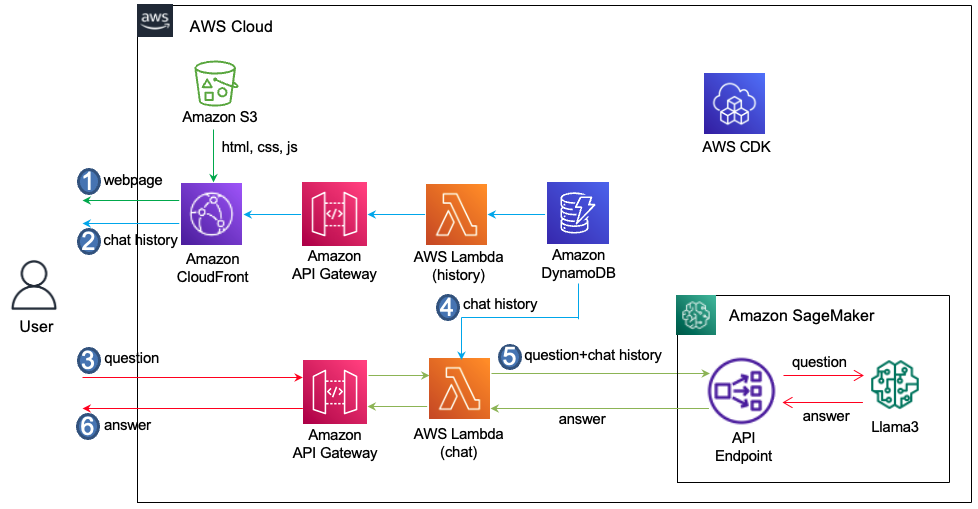여기서는 LLM으로 Llama3를 이용하여 한국어 Chatbot을 만드는 것을 설명합니다. 개발은 LangChain을 활용하였습니다. 전체적인 Architecture는 아래와 같습니다.
SageMaker Endpoint로 LLM을 사용하기 위하여 ContentHandler를 정의합니다.
from langchain.llms.sagemaker_endpoint import LLMContentHandler
class ContentHandler(LLMContentHandler):
content_type = "application/json"
accepts = "application/json"
def transform_input(self, prompt: str, model_kwargs: Dict) -> bytes:
input_str = json.dumps(
{
"inputs": prompt,
"parameters": model_kwargs}
)
return input_str.encode("utf-8")
def transform_output(self, output: bytes) -> str:
response_json = json.loads(output.read().decode("utf-8"))
print('response_json: ', response_json)
return response_json["generated_text"]
content_handler = ContentHandler()boto3 client에서는 service로 "sagemaker-runtime"을 사용학고, 아래와 같이 parameter도 정의할 수 있습니다. 이후 LangChain의 SagemakerEndpoint를 이용해 llm을 정의합니다.
from langchain_community.llms import SagemakerEndpoint
def initiate_LLM():
sagemaker_client = boto3.client(
service_name="sagemaker-runtime",
region_name=aws_region,
)
parameters = {
"max_new_tokens": 1024,
"top_p": 0.9,
"temperature": 0.1,
"stop": "<|eot_id|>"
}
llm = SagemakerEndpoint(
endpoint_name = endpoint_name,
region_name = "us-west-2",
model_kwargs = parameters,
client = sagemaker_client,
endpoint_kwargs={"CustomAttributes": "accept_eula=true"},
content_handler = content_handler
)
return llm채팅이력을 포함하여 답변을 구하기 위하여 아래와 같이 prompt를 구성합니다. 상세한 코드는 lambda-chat을 참조합니다.
def general_conversation(query):
prompt_template = """
<|begin_of_text|>
<|start_header_id|>system<|end_header_id|>\n\n다음의 History는 User와 Assistant의 이전 대화입니다. History를 참조하여 Qustion에 대해 친절히 답변하세요. Always answer without emojis in Korean
History: {chat_history}<|eot_id|>
<|start_header_id|>user<|end_header_id|>\n\n"{text}"<|eot_id|>
<|start_header_id|>assistant<|end_header_id|>\n\n"""
PROMPT = PromptTemplate(
template=prompt_template,
input_variables=["chat_history", "text"]
)
history = memory_chain.load_memory_variables({})["chat_history"]
print('memory_chain: ', history)
chat_history = get_chat_history(history)
print('chat_history: ', chat_history)
llm_chain = LLMChain(llm=llm, prompt=PROMPT)
msg = llm_chain({"text": query, "chat_history": chat_history}, return_only_outputs=True)
return msg['text'] map_chain을 설정합니다.
map_chain = dict()
MSG_LENGTH = 100event가 lambda에 전달될때에 userId를 추출하여 관련된 대화이력을 memory_chain에서 확인합니다. 없는 경우에는 LangChain의 ConversationBufferWindowMemory을 이용해 memory_chain을 설정합니다. 또한 DyanmoDB를 조회하여 이전 대화이력이 있는 경우에 로드 합니다.
# create memory
if userId in map_chain:
memory_chain = map_chain[userId]
print('memory_chain exist. reuse it!')
else:
memory_chain = ConversationBufferWindowMemory(memory_key="chat_history", output_key='answer', return_messages=True, k=4)
map_chain[userId] = memory_chain
print('memory_chain does not exist. create new one!')
allowTime = getAllowTime()
load_chat_history(userId, allowTime)◊
def load_chat_history(userId, allowTime):
dynamodb_client = boto3.client('dynamodb')
print('loading history.')
try:
response = dynamodb_client.query(
TableName=callLogTableName,
KeyConditionExpression='user_id = :userId AND request_time > :allowTime',
ExpressionAttributeValues={
':userId': {'S': userId},
':allowTime': {'S': allowTime}
}
)
print('query result: ', response['Items'])
except Exception:
err_msg = traceback.format_exc()
print('error message: ', err_msg)
raise Exception ("Not able to request to DynamoDB")
for item in response['Items']:
text = item['body']['S']
msg = item['msg']['S']
type = item['type']['S']
if type == 'text':
memory_chain.chat_memory.add_user_message(text)
if len(msg) > MSG_LENGTH:
memory_chain.chat_memory.add_ai_message(msg[:MSG_LENGTH])
else:
memory_chain.chat_memory.add_ai_message(msg)신규 대화 이력은 아래와 같이 저장합니다.
memory_chain.chat_memory.add_user_message(text)
memory_chain.chat_memory.add_ai_message(msg)이 솔루션을 사용하기 위해서는 사전에 아래와 같은 준비가 되어야 합니다.
- AWS Account 생성에 따라 계정을 준비합니다.
본 실습에서는 Seoul 리전 (ap-northeast-2)을 사용합니다. 인프라 설치에 따라 CDK로 인프라 설치를 진행합니다.
입력창에 "서울 여행하는 방법 알려줘"로 입력후 결과를 확인합니다.
error_code.pdf을 다운받은 후에 업로드를 하고 결과를 확인합니다.
작은 모델이라서 Hallucination은 피할수 없는것 같습니다. 사용 목적에 맞는 Prompt를 기반으로 RAG와 결합하여 써야 할것 같습니다.
더이상 인프라를 사용하지 않는 경우에 아래처럼 모든 리소스를 삭제할 수 있습니다.
-
API Gateway Console로 접속하여 "rest-api-for-llama3-langchain-kor", "ws-api-for-llama3-langchain-kor"을 삭제합니다.
-
Cloud9 Console에 접속하여 아래의 명령어로 전체 삭제를 합니다.
cd ~/environment/llama3-langchain-kor/cdk-llama3-korg/ && cdk destroy --all
LangChain을 이용하여 Llama3로 한국어 Chatbot을 만들었습니다. Llama2에서는 지원하지 않던 한국어가 괜찮은 성능으로 제공되고 있으며, 문서 요약 성능도 우수한것으로 보여집니다. 추가 테스트를 통해 활용방안을 확인할 예정입니다.




